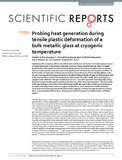JavaScript is disabled for your browser. Some features of this site may not work without it.
| dc.contributor.author | Brennhaugen, David D. E. | |
| dc.contributor.author | Georgarakis, Konstantinos | |
| dc.contributor.author | Yokoyama, Yoshihiko | |
| dc.contributor.author | Nakayama, Koji S. | |
| dc.contributor.author | Arnberg, Lars | |
| dc.contributor.author | Aune, Ragnhild E. | |
| dc.date.accessioned | 2018-12-10T12:36:42Z | |
| dc.date.available | 2018-12-10T12:36:42Z | |
| dc.date.issued | 2018-11-05 | |
| dc.identifier.citation | David D. E. Brennhaugen, Konstantinos Georgarakis, Yoshihiko Yokoyama, et al., Probing heat generation during tensile plastic deformation of a bulk metallic glass at cryogenic temperature. Scientific Reports, Volume 8, Article number: 16317 (2018) | en_UK |
| dc.identifier.issn | 2045-2322 | |
| dc.identifier.uri | https://doi.org/10.1038/s41598-018-34681-4 | |
| dc.identifier.uri | https://dspace.lib.cranfield.ac.uk/handle/1826/13708 | |
| dc.description.abstract | Despite significant research efforts, the deformation and failure mechanisms of metallic glasses remain not well understood. In the absence of periodic structure, these materials typically deform in highly localized, thin shear bands at ambient and low temperatures. This process usually leads to an abrupt fracture, hindering their wider use in structural applications. The dynamics and temperature effects on the formation and operation of those shear bands have been the focus of long-standing debate. Here, we use a new experimental approach based on localized boiling of liquid nitrogen by the heat generated in the shear bands to monitor the tensile plastic deformation of a bulk metallic glass submerged in a cryogenic bath. With the “nitrogen bubbles heat sensor”, we could capture the heat dissipation along the primary shear banding plane and follow the dynamics of the shear band operation. The observation of nitrogen boiling on the surface of the deforming metallic glass gives direct evidence of temperature increase in the shear bands, even at cryogenic temperatures. An acceleration in bubble nucleation towards the end of the apparent plastic deformation suggests a change from steady-state to runaway shear and premonitions the fracture, allowing us to resolve the sequence of deformation and failure events. | en_UK |
| dc.language.iso | en | en_UK |
| dc.publisher | Nature Publishing Group | en_UK |
| dc.rights | Attribution 4.0 International | * |
| dc.rights.uri | http://creativecommons.org/licenses/by/4.0/ | * |
| dc.title | Probing heat generation during tensile plastic deformation of a bulk metallic glass at cryogenic temperature | en_UK |
| dc.type | Article | en_UK |
| dc.identifier.cris | 22247056 |
Files in this item
The following license files are associated with this item:
This item appears in the following Collection(s)
-
Staff publications (SATM) [4406]

